The Darkstar
Weapon Sight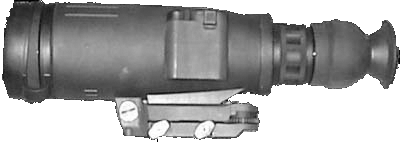
| Tube |
Lens |
Power |
Dimensions |
Construction |
Type |
| Gen. I I (S-25) |
95mm F 1.2 (4X) |
2xAA (20 hrs.) |
12.5x3.25(wo/mnt) |
Molded Plastic |
Weapon Sight |
This is a Darkstar, weaponsight
by Tactical Night Technologies (TNT). It has a total system gain of 3,000.
This is not impressive for a second generation device, but is a consequence
of the need for magnification, and for keeping the scope as compact as possible.
The second generation tube itself has a gain of around 25,000. In the 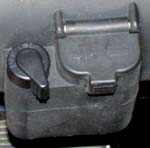 fashion of the AN/PVS-4, the optical
system is a catodiaptric unit. In this case it gives a magnification of 4X,
with a focal length of 95mm, and an aperture of F 1.2. The picture is considerably
clearer, brighter, and "cleaner" than what I am used to from my old first
generation unit, and even with the telescopic optics, is considerably more
sensitive.. The scope is well made, and feature filled. The objective, and
the eyepiece can each be focused separately. The on/off switch has four different
intensity settings for shooting (or viewing) under differing light conditions.
The unit includes a real daylight filter, not just a plastic lens cap with
a pinhole in the center. It also includes a very well made, padded, waterproof
case. There is a tripod fitting for the non-shooting night enthusiast to help
steady the unit. Along with it's enhanced sensitivity to visible light, the
Darkstar is I.R. sensitive, so that at extended distances, or in total darkness,
an I.R. illuminator may be used. The Dark Star runs off of
a pair of common AA batteries.
fashion of the AN/PVS-4, the optical
system is a catodiaptric unit. In this case it gives a magnification of 4X,
with a focal length of 95mm, and an aperture of F 1.2. The picture is considerably
clearer, brighter, and "cleaner" than what I am used to from my old first
generation unit, and even with the telescopic optics, is considerably more
sensitive.. The scope is well made, and feature filled. The objective, and
the eyepiece can each be focused separately. The on/off switch has four different
intensity settings for shooting (or viewing) under differing light conditions.
The unit includes a real daylight filter, not just a plastic lens cap with
a pinhole in the center. It also includes a very well made, padded, waterproof
case. There is a tripod fitting for the non-shooting night enthusiast to help
steady the unit. Along with it's enhanced sensitivity to visible light, the
Darkstar is I.R. sensitive, so that at extended distances, or in total darkness,
an I.R. illuminator may be used. The Dark Star runs off of
a pair of common AA batteries.
There is a chevron reticle which
not only serves as an aiming point, but also acts as a ranging aid. This
is used in the manner of a front post sight in a departure from the more
common cross hairs seen in most scopes. There are several ranging marks on 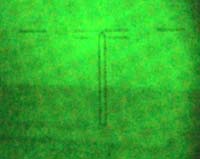 and around the chevron, to aid the shooter in the difficult conditions under
which this type of scope will most often be used. The aids and the reticle
are black, and can be a bit difficult to see under extreme conditions. When
firing in these circumstances it would be best, even with a second generation
scope, to use an illuminator. The manual, and the calibration make no excuses
or apologies as to the purpose of the scope. This is a sniper scope, and
no pretense is made as to it's being designed for shooting at deer, woodchucks,
or coyotes. The calibration of the ranging aid, and the instructions for
ranging, all base themselves on sighting for a man sized target.
and around the chevron, to aid the shooter in the difficult conditions under
which this type of scope will most often be used. The aids and the reticle
are black, and can be a bit difficult to see under extreme conditions. When
firing in these circumstances it would be best, even with a second generation
scope, to use an illuminator. The manual, and the calibration make no excuses
or apologies as to the purpose of the scope. This is a sniper scope, and
no pretense is made as to it's being designed for shooting at deer, woodchucks,
or coyotes. The calibration of the ranging aid, and the instructions for
ranging, all base themselves on sighting for a man sized target.
There is a large rubber eyepiece
which is soft enough to mold to the contours of the viewer's face. This eyepiece
has a shutter on it to prevent the escape of stray light from illuminating
the shooter's face. The shutter opens when the eyepiece is pressed firmly
against the viewer's face. The scope has a dull mat gray finish, in keeping
with the military style. Also in deference to the military nature of this
scope is the flash protection, designed to rapidly respond to any sudden
increases in light, such as muzzle flash, by reducing tube voltage. In a
variation of this, is the non-blooming feature, which prevents pin point
areas of bright light from overloading the tube. In general, all of these
features tend to be directed towards the military user.
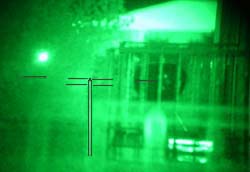 This scope mates to a common Weaver base through the well regarded
Hughes Elcan mount. This mount eliminates the need for internal adjustments
on the scope, allowing for better integrity, and increased durability, as
the scope body need not be pierced for adjustment screws or other such things.
It also simplifies the construction a bit, and removes one more delicate
component from maintenance considerations. The mount is easy to zero, and,
once set, may be used to range out to 800 yards. Range settings aside, I
consider this to be a good scope for a carbine or, even better, an assault
rifle. This is in consideration of the scope's power of 4x. This is not really
sufficient for true long range shooting, but is just about right for the
100-200 yard range of the carbine, or the 300-500 yard maximum practical
range of an assault rifle. It's size, and it's weight of four pounds may
make it a bit cumbersome on these lighter weapons, but this is far less cumbersome
than any attempt to hit a target that can not be seen because of the dark.
This scope mates to a common Weaver base through the well regarded
Hughes Elcan mount. This mount eliminates the need for internal adjustments
on the scope, allowing for better integrity, and increased durability, as
the scope body need not be pierced for adjustment screws or other such things.
It also simplifies the construction a bit, and removes one more delicate
component from maintenance considerations. The mount is easy to zero, and,
once set, may be used to range out to 800 yards. Range settings aside, I
consider this to be a good scope for a carbine or, even better, an assault
rifle. This is in consideration of the scope's power of 4x. This is not really
sufficient for true long range shooting, but is just about right for the
100-200 yard range of the carbine, or the 300-500 yard maximum practical
range of an assault rifle. It's size, and it's weight of four pounds may
make it a bit cumbersome on these lighter weapons, but this is far less cumbersome
than any attempt to hit a target that can not be seen because of the dark.
I took the scope out almost immediately
after receiving it, to get some demo pictures, and discovered an interesting
thing. I can not use the scope at full power for street scenes without the
auto protection circuit kicking in. The auto protection circuit keeps the
tube from whiting out or, in extreme cases, burning itself when exposed to
too much light. The eyepiece makes it rather difficult to put a camera on
this scope, and I will have to do some experimentation. There may be a way
to remove the eyepiece, but I haven't really checked into this yet. In the
meantime, I am trying to decide which rifle to put it on. Perhaps my standard
model AR-15, 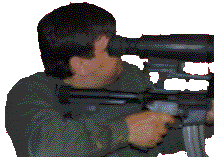 since the calibration of
since the calibration of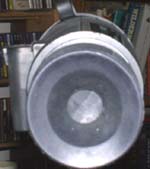 the reticle is pretty well matched
to the .223 cartridge. One drawback to an NVD rifle scope is that there are few places where it can really
be used. Hunting at night is illegal, and the scopes are poorly suited to shooting during the day. Still, the scope
is a great addition to a collection, looks good on an assault rifle, and
may be handy for varmint hunting or pest control in places which are out
of the way. It is also one of many items which may be banned in the near
future, as has already happened in Europe, China, India, Australia, and Japan.
Get them while you can.
the reticle is pretty well matched
to the .223 cartridge. One drawback to an NVD rifle scope is that there are few places where it can really
be used. Hunting at night is illegal, and the scopes are poorly suited to shooting during the day. Still, the scope
is a great addition to a collection, looks good on an assault rifle, and
may be handy for varmint hunting or pest control in places which are out
of the way. It is also one of many items which may be banned in the near
future, as has already happened in Europe, China, India, Australia, and Japan.
Get them while you can.
|